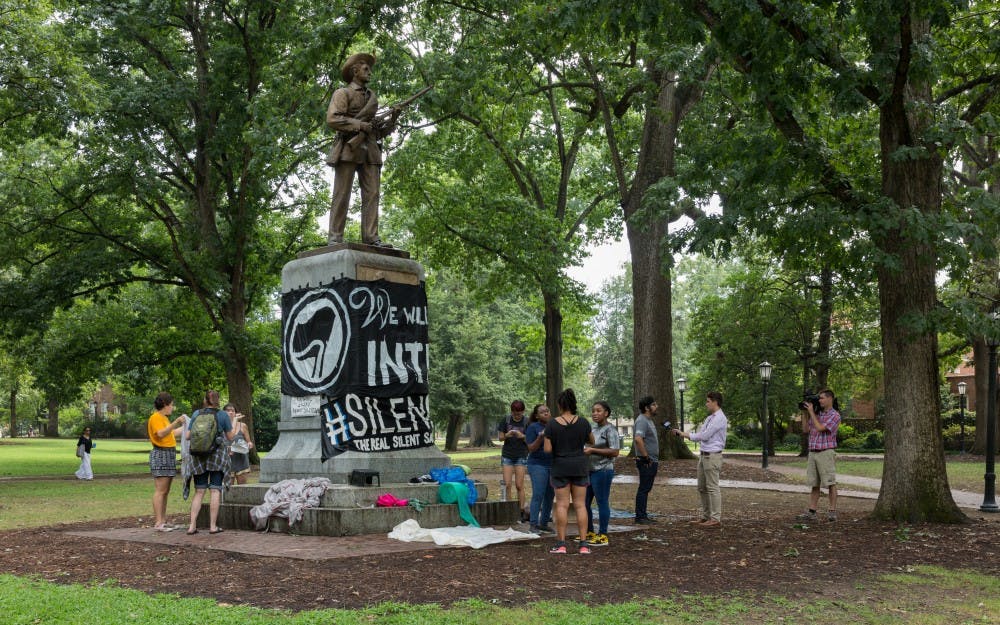In the months since protesters pulled down the University of North Carolina-Chapel Hill's “Silent Sam," a Confederate monument, the statue's place on campus has been mired in debate. This timeline provides context for its creation, the subsequent controversy and what the future entails.
1908: The United Daughters of the Confederacy proposed building the statue to honor the "Chapel Hill Boys" who left college to join the Confederate Army. John Wilson sculpted the statue and images on the base and modeled it on Harold Langlois, a young man in Boston. The project cost $7,500—equivalent to roughly $200,000 today.
June 2, 1913: Delayed by two years due to fundraising difficulties, UNC formally unveiled Silent Sam to the public. Governor Locke Craig spoke at the ceremony, as did Civil War veteran Julian Carr, who boasted about “horse-whipping” a black woman for insulting a Southern lady.
1955-1968: UNC officially integrated its student body in 1955, and conversations about Silent Sam’s presence evolved as a result of the broader Civil Rights Movement. After Martin Luther King Jr.’s assassination in April 1968, students defiled the monument for the first time.
2011: UNC history graduate student Adam Domby unearthed the transcript of the dedication ceremony from 1913 and published his findings in The Daily Tar Heel in a letter to the editor, quoting Carr’s remarks. Students calling themselves the “Real Silent Sam Movement” then attracted the attention of national leaders, such as former North Carolina NAACP president Rev. William Barber II, to the statue.
2015: Silent Sam was vandalized several times in 2015. That year, the North Carolina General Assembly also passed the Cultural History Artifact and Patriotism Act, which barred the permanent removal of any “object of remembrance” without the approval of the North Carolina Legislature.
August 2017: At the “Unite the Right” rally, the so-called “alt-right” and counter-protesters clashed in Charlottesville, Va., about the removal of a Robert E. Lee statue. Just days after, protesters toppled a Confederate monument in Durham. In the wake of these events, Chapel Hill Mayor Pam Hemminger asked the university to remove the statue and Chancellor Carol Folt said in September that it would be best for the statue to be moved. However, she said that the university would follow the law—which banned the statue's removal without the state legislature's approval.
September 2017-April 2018: Debate raged throughout the year. Activists petitioned Folt, holding rallies outside her office.
April 30, 2018: Maya Little, a history doctoral student, splattered red paint and blood on Silent Sam, justifying the action as “providing historical context” for white supremacy. The University charged Little, who was arrested, with an honor code violation.
Aug. 20, 2018: Protesters gathered around Silent Sam and tore down the statue. Police arrested several participants. Groundskeepers drove the statue to an undisclosed storage location. The next day, UNC and Chapel Hill leaders issued the following joint statement:
"Last night's rally was unlike any previous event on our campus," the statement read. "This protest was carried out in a highly organized manner and included a number of people unaffiliated with the University. While we respect that protesters have the right to demonstrate, they do not have the right to damage state property."
August 31, 2018: A neo-Confederate group rallied at the site where Silent Sam once stood, but the group was heavily outnumbered by counter-protesters.
Oct. 26, 2018: The undergraduate Honor Court ruled that Little violated the school’s honor code and sanctioned her with 18 hours of community service and a letter of warning. Little has since appealed the ruling, saying that she did not receive a "fair and impartial trial." The case has not yet been decided.
Present: University leaders have said they will have a proposal on what to do with the statue before the Dec. 14 Board of Governors meeting.
Get The Chronicle straight to your inbox
Signup for our weekly newsletter. Cancel at any time.

